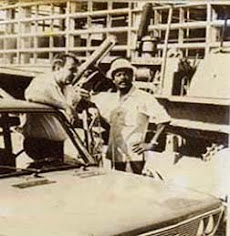By Sergio Giral
In film making terminology Fade
to Black means just what it implies,
the disappearance of the image on
the screen until all colors become black leaving nothing but a black screen. Something
similar happens with Black Hispanics on television networks.
Latino immigration has caused
a major shift in the demographic complexion of United State, where Cubans have
gone to be the largest, living about 80% in Miami. Among these growing demography
are the Black Latinos, who have gone largely unnoticed, not only to White and
Black Americans, but also to Latino Americans whose own social structure
historically has alienated them as a result of race.
To this end, popular culture
may provide some insight, especially if we examine television – the epitome of
an American popular culture. It’s known that television’s publicity spots and
commercials are targeted to attract consumers and soap operas pursue ratings to
accomplish sponsors investment, yet Latino TV producers avoid the presence of the
Black talents on their programs. Let’s
take Miami for an example.
It's seldom when nor isolated to find Black performers, anchors and programs conductors in Miami Spanish networks. Yet sport, musicians and singers are exceptions. I have the experience to be invited to a TV program and asked if I'm a musician. Why not a philosopher, a politicians or a film director? It's clear the own network suffers from lack of Black talents.
In 1959, Fidel Castro
attacked the existing racial discrimination encouraging the idealistic view
that it was possible to forget about racism. The case was declared solved.
Since then, discussions and studies of race and racism providing an accurate
picture of racial divisions on the island have been officially silenced and
provoked for many years that any approach toward racial inequalities in Cuba
were considered shameful and unnecessary and finally a Taboo issue.
Regardless the Cuban
government promised social achievements such as free education and free health
care, Cuba continuously fall down into economic crisis lower down white middle
class into the traditional Black population economical status, creating a false
impression of an egalitarian society. Cubans
living under a totalitarian have developed a system of survival for their needs
according to what restrictions are imposed the State. Consider well the Black
population.
For
many years Blacks in Cuba were wrongly perceived as supporters of the Castro’s
regime, due to the myth of an improved quality of life. Opposite to this believe
Black Cubans suffer discrimination and are considered alleged delinquents and
drifters by the authorities. The penal population is almost
exclusively Black. Currently, blacks and mulattos continue to be discriminated against in
government leadership positions.
Focusing on Cuba’s exiled community,
the first leap to Miami was wealthy and well-educated white elite who spoke English
and settled in South Florida where topographical, cultural and language
similarities afforded them the easiest opportunity for assimilation into U.S.
society. Assimilation, however, proved
to be more to difficult for Black and mestizo
Cubans, especially in the traditional, racial social structure of South Florida
and Miami-Dade County, in particular.
Castro’s own propaganda about
social equality in Cuba and traditional racial discrimination in United States
accomplished Blacks Cubans fear to be exiled.However, by 1965, the United
States’ history of segregation and racism was superseded to by the achievements
of its Civil Rights Movement. As a
result, the potential for racial equality in the United States soon became a
contributing factor in many Black Cubans’ decision to immigrate to the United
States on the Mariel’s migration and the 1995 boat lift. To this end, many Black
Cubans migrated to cities like New York, where other Black Latino groups had
established a large and important presence.
Lately the significant
compositions of Black Cuban political dissidents visiting USA has produced
their presence on some Miami TV programs, proving the importance of this ethnic
group on social and political Cuban life. But once again the absence of Blacks
on regular programming appears to prove that Black Latinos and especially Black
Cubans are a non-existent in United States or are obviously insignificant in
contemporary American society.
It’s difficult to assess the
impact and role of Black Latinos in American society today, as even Census data
fails to accurately report upon them, allowed for the counting as “Hispanics”,
but limited the reporting their race or ethnic.
In South Florida, for example, 2010 census declare
75% Florida’s population to be white (57.9%
were Hispanic white) and the second largest ethnic group were Black or African
American at 16%, but never
reported on the percentage of the count that was actually multiracial or
specifically, Black Latinos. In other
words, without specific data on Latino African descendants seems hard to accomplish a recording
of the Black Latino and Black Cubans presence in U.S. Nevertheless Black Latinos and Black Cubans represent a demography minority
group in South Florida and especially in Miami, they have played an essential
cultural and social role in their nation’s history that should be recognized on
the American popular culture, avoiding them to Fade to Black on the small
screen.

















No comments:
Post a Comment